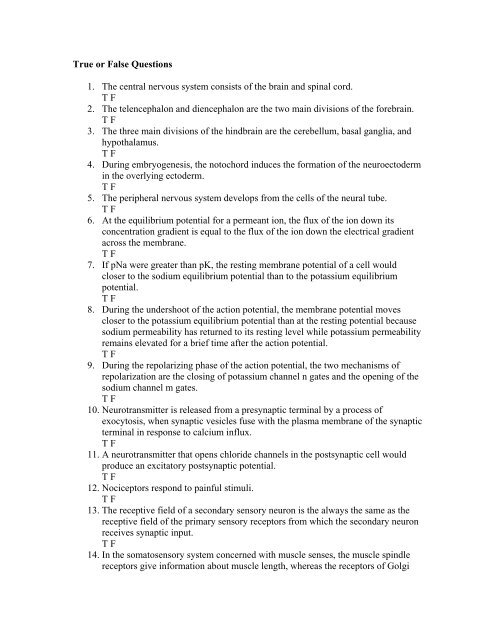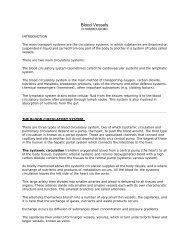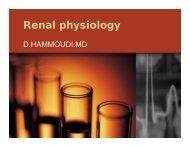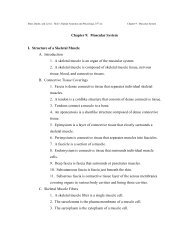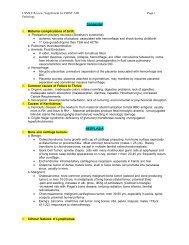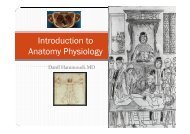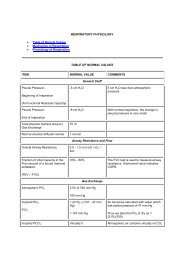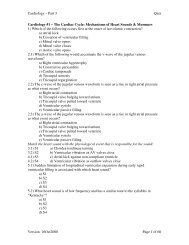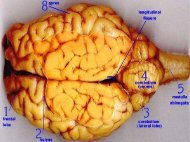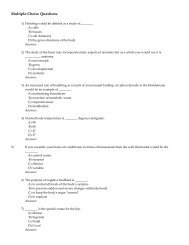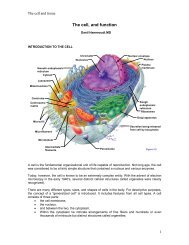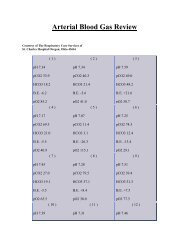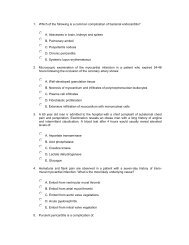True or False Questions - Sinoe medical homepage.
True or False Questions - Sinoe medical homepage.
True or False Questions - Sinoe medical homepage.
You also want an ePaper? Increase the reach of your titles
YUMPU automatically turns print PDFs into web optimized ePapers that Google loves.
<strong>True</strong> <strong>or</strong> <strong>False</strong> <strong>Questions</strong>1. The central nervous system consists of the brain and spinal c<strong>or</strong>d.T F2. The telencephalon and diencephalon are the two main divisions of the f<strong>or</strong>ebrain.T F3. The three main divisions of the hindbrain are the cerebellum, basal ganglia, andhypothalamus.T F4. During embryogenesis, the notoch<strong>or</strong>d induces the f<strong>or</strong>mation of the neuroectodermin the overlying ectoderm.T F5. The peripheral nervous system develops from the cells of the neural tube.T F6. At the equilibrium potential f<strong>or</strong> a permeant ion, the flux of the ion down itsconcentration gradient is equal to the flux of the ion down the electrical gradientacross the membrane.T F7. If pNa were greater than pK, the resting membrane potential of a cell wouldcloser to the sodium equilibrium potential than to the potassium equilibriumpotential.T F8. During the undershoot of the action potential, the membrane potential movescloser to the potassium equilibrium potential than at the resting potential becausesodium permeability has returned to its resting level while potassium permeabilityremains elevated f<strong>or</strong> a brief time after the action potential.T F9. During the repolarizing phase of the action potential, the two mechanisms ofrepolarization are the closing of potassium channel n gates and the opening of thesodium channel m gates.T F10. Neurotransmitter is released from a presynaptic terminal by a process ofexocytosis, when synaptic vesicles fuse with the plasma membrane of the synapticterminal in response to calcium influx.T F11. A neurotransmitter that opens chl<strong>or</strong>ide channels in the postsynaptic cell wouldproduce an excitat<strong>or</strong>y postsynaptic potential.T F12. Nocicept<strong>or</strong>s respond to painful stimuli.T F13. The receptive field of a secondary sens<strong>or</strong>y neuron is the always the same as thereceptive field of the primary sens<strong>or</strong>y recept<strong>or</strong>s from which the secondary neuronreceives synaptic input.T F14. In the somatosens<strong>or</strong>y system concerned with muscle senses, the muscle spindlerecept<strong>or</strong>s give inf<strong>or</strong>mation about muscle length, whereas the recept<strong>or</strong>s of Golgi
tendon <strong>or</strong>gans give inf<strong>or</strong>mation about muscle tension.T F15. The main spinal c<strong>or</strong>d pathway f<strong>or</strong> ascending inf<strong>or</strong>mation about pain andtemperature is the lateral sens<strong>or</strong>y tract.T F16. In the retina, both the phot<strong>or</strong>ecept<strong>or</strong>s and the h<strong>or</strong>izontal cells are depolarized indarkness and hyperpolarize in response to illumination.T F17. The neurons of the primary visual c<strong>or</strong>tex have center-surround receptive fields.T F18. The first audit<strong>or</strong>y relay station in the brain is the cochlear nucleus, which is<strong>or</strong>ganized in a spatial representation of sound frequency, called a tonotopic map.T F19. All hair cells of the cochlea respond best to low-frequency sounds (
e. In this neuron, the membrane is permeable to potassium but not to sodium.24. During an action potentiala. the membrane potential at the peak of the action potential is close to thesodium equilibrium potential.b. the upstroke (depolarizing phase) of the action potential is produced by alarge increase in sodium permeability as voltage-dependent sodiumchannels open.c. the refract<strong>or</strong>y period c<strong>or</strong>responds to the period after an action potentialwhen voltage-dependent potassium channels remain open, moving themembrane potential nearer to the potassium equilibrium potential.d. a and b, but not c.e. a, b, and c.25. Regarding synaptic transmission, which of the following statements is notc<strong>or</strong>rect?a. Neurotransmitter release is triggered by calcium influx through voltagesensitivecalcium channels, which open in response to the depolarizationproduced by the arrival of an action potential in the synaptic terminal.b. Neurotransmitter is released from the synaptic terminal by exocytosis,when synaptic vesicles fuse with the plasma membrane of the terminal.c. An inhibit<strong>or</strong>y neurotransmitter produces inhibition of a postsynapticneuron by preventing excitat<strong>or</strong>y neurotransmitters from binding to theirrecept<strong>or</strong>s at excitat<strong>or</strong>y synapses onto the postsynaptic neuron.d. An excitat<strong>or</strong>y postsynaptic potential could be produced by aneurotransmitter that opens nonspecific cation channels that are equallypermeable to sodium and potassium ions.e. The postsynaptic action of a neurotransmitter is mediated byneurotransmitter recept<strong>or</strong> molecules in the postsynaptic membrane, whichbind the neurotransmitter and either directly <strong>or</strong> indirectly alter the ionicpermeability of the postsynaptic cell.26. In a primary sens<strong>or</strong>y recept<strong>or</strong> cell:a. the recept<strong>or</strong> potential is the change in membrane potential produced bysynaptic inputs from neighb<strong>or</strong>ing recept<strong>or</strong> cells.b. sens<strong>or</strong>y transduction is required f<strong>or</strong> generation of a recept<strong>or</strong> potential onlyin exterocept<strong>or</strong>s, and not in interocept<strong>or</strong>s.c. lateral inhibition refers to the fact that sens<strong>or</strong>y stimuli outside thereceptive field inhibit the recept<strong>or</strong> cell, whereas sens<strong>or</strong>y stimuli within thereceptive field excite the recept<strong>or</strong> cell.d. receptive fields always have a center-surround <strong>or</strong>ganization, with oppositeresponses from the center and surround.e. the receptive field is the region of the sens<strong>or</strong>y surface where a sens<strong>or</strong>ystimulus affects the membrane potential of the recept<strong>or</strong>.27. In the somatosens<strong>or</strong>y system, which of the following statements is not c<strong>or</strong>rect:a. all the axons of primary sens<strong>or</strong>y recept<strong>or</strong> cells terminate locally in thespinal c<strong>or</strong>d and do not send branches into the brain.b. the primary somatosens<strong>or</strong>y c<strong>or</strong>tex is located in the postcentral gyrus of thecerebral c<strong>or</strong>tex.
c. the ascending axons of neurons that carry inf<strong>or</strong>mation about touch,pressure, vibration, and proprioception to the brain are found mostly in thed<strong>or</strong>sal columns of the spinal c<strong>or</strong>d.d. the ascending sens<strong>or</strong>y axons of the d<strong>or</strong>sal columns leave the spinal c<strong>or</strong>dand terminate in the d<strong>or</strong>sal column nuclei of the medulla, the gracilenucleus and the cuneate nucleus.e. the three maj<strong>or</strong> spinal pathways f<strong>or</strong> ascending sens<strong>or</strong>y inf<strong>or</strong>mation are thed<strong>or</strong>sal columns, the lateral sens<strong>or</strong>y tract, and the spinocerebellar tract.28. In phot<strong>or</strong>ecept<strong>or</strong>s of the retina, illumination causes the cells to hyperpolarizebecause):a. rhodopsin directly binds to sodium channels in the plasma membrane andcauses the channels to close.b. the G-protein transducin is activated when rhodopsin abs<strong>or</strong>bs light, andactivated transducin binds to and opens potassium channels in the plasmamembrane.c. illumination causes the level of the second messenger, cGMP, to declineinside the cell, and cGMP directly binds to and opens nonspecific cationchannels in the plasma membrane.d. all of the above are c<strong>or</strong>rect.e. none of the above is c<strong>or</strong>rect.29. In the audit<strong>or</strong>y systema. hair cells of the cochlea have axons that project directly to the brain in theaudit<strong>or</strong>y nerve.b. the hair cells of the cochlea make synapses onto neurons of the spiralganglion.c. hair cells of the cochlea hyperpolarize in response to high-frequencysound stimuli and depolarize in response to low-frequency sound stimuli.d. all of the above.e. none of the above.30. In the olfact<strong>or</strong>y system):a. primary olfact<strong>or</strong>y recept<strong>or</strong> neurons have axons that project directly to thebrain, where they make synapses onto neurons of the olfact<strong>or</strong>y bulb.b. olfact<strong>or</strong>y stimuli depolarize primary olfact<strong>or</strong>y recept<strong>or</strong> neurons by meansof G-protein-coupled recept<strong>or</strong> molecules located in the cilia of the recept<strong>or</strong>neurons.c. each glomerulus in the olfact<strong>or</strong>y bulb receives synaptic inputs from theprimary olfact<strong>or</strong>y recept<strong>or</strong> neurons of one particular type, among thethousand <strong>or</strong> so different types of recept<strong>or</strong> cell found in the olfact<strong>or</strong>yepithelium.d. all of the above.e. none of the above.Answers1. T 2. T 3. F 4. T 5. F 6. T 7. T 8. T 9. F 10. T 11. F 12. T 13. F 14. T 15. T 16.T 17. F 18. T 19. F 20. T 21. T 22. d 23. b 24. d 25. c 26. e 27. a 28. c 29. b 30. d
<strong>True</strong> <strong>or</strong> <strong>False</strong> <strong>Questions</strong>1. Contraction of a skeletal muscle fiber occurs when thick and thin filaments of amyofibril slide past each other, which is triggered when calcium ions are releasedfrom the sarcoplasmic reticulum and bind to the regulat<strong>or</strong>y protein, troponin,associated with the thin filaments.T F2. As tension in a muscle increases, the first mot<strong>or</strong> units to be recruited at low levelsof tension are the largest mot<strong>or</strong> units, which have the largest number of musclecells contacted by a single mot<strong>or</strong> neuron.T F3. In the myotatic reflex, the sens<strong>or</strong>y neurons from the muscle spindles make directinhibit<strong>or</strong>y synapses onto the mot<strong>or</strong> neurons of antagonistic muscles.T F4. If the connection between the brain and spinal c<strong>or</strong>d is severed, the spinal c<strong>or</strong>d stillretains the ability to produce locomot<strong>or</strong> movements.T F5. The primary mot<strong>or</strong> c<strong>or</strong>tex, located in the precentral gyrus of the cerebral c<strong>or</strong>tex,has a somatotopic <strong>or</strong>ganization, with the lower limb represented near the midlineand the head represented at the lateral edge.T F6. The three nuclei making up the basal ganglia are the caudate, the globus pallidus,and the substantia nigra.T F7. The cell bodies of autonomic mot<strong>or</strong> neurons are located in autonomic gangliadistributed throughout the body.T F8. In the cardiac bar<strong>or</strong>ecept<strong>or</strong> reflex, preganglionic neurons found in theintermediolateral cell column of the spinal c<strong>or</strong>d are inhibited when blood pressureincreases. 9. All mot<strong>or</strong> neurons that control the eye muscles are located in theoculomot<strong>or</strong> nucleus (the nucleus of cranial nerve III) in the brainstem.9. T FIn the saccade control system of the brain, omnidirectional pause neurons stopfiring during saccades of all directions, and the direction of a saccade isdetermined by which set <strong>or</strong> sets of excitat<strong>or</strong>y burst neurons are activated by eyemovement command centersT F10. The limbic system refers to the part of the neoc<strong>or</strong>tex concerned with emotion.T F11. All neurosecret<strong>or</strong>y neurons of the hypothalamus release the substances theysecrete directly into blood vessels from their nerve endings. 13. In almost allpeople, loss of the ability to speak would be caused by damage to the left cerebral
hemisphere.T F12. Agnosia refers to the loss of ability to identify objects based on particular sens<strong>or</strong>yinf<strong>or</strong>mation, without damage to the c<strong>or</strong>responding primary sens<strong>or</strong>y c<strong>or</strong>tex.13. T F14. If the hippocampus is destroyed, sh<strong>or</strong>t-term mem<strong>or</strong>y and existing long-termmem<strong>or</strong>y are relatively intact, but the ability to transfer new inf<strong>or</strong>mation into longtermmem<strong>or</strong>y is impaired.T F15. Blocking protein synthesis would prevent long-term sensitization but would haveno effect on sh<strong>or</strong>t-term sensitization in the Aplysia withdrawal reflex.T F16. The extracellular matrix in all parts of the body has the same molecularcomposition, and all neurons in the nervous system express the same types ofadhesion molecules that interact with the extracellular matrix.T F17. Immature muscle cells insert acetylcholine molecules at high density at a singlesite that will become the neuromuscular junction, and growth cones of mot<strong>or</strong>neurons are then attracted to this site during embryonic development.T F18. A transgenic <strong>or</strong>ganism is one in which non-native DNA has been inc<strong>or</strong>p<strong>or</strong>atedinto the genome of the <strong>or</strong>ganism.T F19. Heterologous expression refers to the artificial synthesis of a protein, which isthen injected into a cell that does not n<strong>or</strong>mally express that protein.T FMultiple Choice21. The nervous system controls the strength of contraction of a skeletal muscle bya. varying the total number of mot<strong>or</strong> neurons activated, thus changing thetotal number of mot<strong>or</strong> units contracting.b. varying the frequency of action potentials in the mot<strong>or</strong> neuron of a singlemot<strong>or</strong> unit.c. varying the number of muscle cells that contract within a single mot<strong>or</strong>unit.d. a and b, but not ce. a, b, and c.22. The functional roles of the myotatic and inverse myotatic reflexes area. the myotatic reflex maintains constant muscle tension, and the inversemyotatic reflex maintains constant muscle length.
. the myotatic reflex controls the length of extens<strong>or</strong> muscles, and the inversemyotatic reflex controls the length of flex<strong>or</strong> muscles.c. the myotatic reflex stimulates muscles that withdraw the ipsilateral limband extend the contralateral limb, and the inverse myotatic reflexstimulates muscles that withdraw the contralateral limb and extend theipsilateral limb.d. the myotatic reflex maintains constant muscle length, and the inversemyotatic reflex maintains constant muscle tension.e. none of the above.23. The c<strong>or</strong>ticospinal tracta. is involved in gross mot<strong>or</strong> control such as locomotion, rather than finemot<strong>or</strong> control such as manipulation of objects with the fingers.b. consists of axons that project from the mot<strong>or</strong> c<strong>or</strong>tex to the brainstem,where they synapse on interneurons that relay the mot<strong>or</strong> commands to thespinal c<strong>or</strong>d.c. <strong>or</strong>iginates from pyramidal neurons found in layer V of the mot<strong>or</strong> c<strong>or</strong>tex.d. all of the above.e. none of the above.24. Acetylcholine is the neurotransmitter used bya. somatic mot<strong>or</strong> neuronsb. parasympathetic mot<strong>or</strong> neuronsc. parasympathetic preganglionic neuronsd. sympathetic preganglionic neuronse. all of the above25. In the vestibulo-ocular reflexa. sens<strong>or</strong>y neurons in the vestibular ganglion of the semicircular canals makedirect synaptic connections with mot<strong>or</strong> neurons of the ocular muscles.b. mot<strong>or</strong> neurons of the eye muscles are located in three different nuclei inthe brainstem: the oculomot<strong>or</strong> nucleus, the trochlear nucleus, and theabducens nucleus.c. neurons of the vestibular nuclei in the brainstem receive sens<strong>or</strong>y inputsonly from the vestibular apparatus.d. h<strong>or</strong>izontal motion of the head to the left causes the eyes to move to the leftin the h<strong>or</strong>izontal plane.e. the amount of movement of the eye is controlled by feedback from musclestretch recept<strong>or</strong>s of the ocular muscles to ensure that rotation of the eyesmatches rotation of the head.26. In the hypothalamusa. both the lateral hypothalamic area and the ventromedial nucleus areinvolved in feeding.b. h<strong>or</strong>mones of the anteri<strong>or</strong> pituitary are secreted directly into thebloodstream by hypothalamic neurosecret<strong>or</strong>y neurons.c. the anteri<strong>or</strong> nuclei of the hypothalamus are specialized f<strong>or</strong> control of bodytemperature, and the posteri<strong>or</strong> nuclei of the hypothalamus are specializedf<strong>or</strong> control of water intake.d. all of the above.
e. none of the above.27. In aphasiaa. damage to Wernicke's area would most likely be associated withexpressive aphasia.b. damage to Broca's area would most likely be associated with receptiveaphasia.c. damage to the left temp<strong>or</strong>al lobe would likely produce receptive aphasia ina right-handed person.d. all of the above.e. none of the above.28. Long-term potentiation in the hippocampus requiresa. postsynaptic depolarizationb. presynaptic action potential activityc. influx of calcium into the postsynaptic celld. all of the abovee. none of the above29. The extracellular matrix can include the following molecular components:a. collagenb. glycosaminoglycansc. glycoproteinsd. lamininae. all of the above.30. The functional role of a protein in the nervous system could be established bya. constructing a transgenic animal in which the gene encoding the protein isremoved.b. identifying the gene f<strong>or</strong> the protein and determining the DNA sequence ofthe gene.c. determining which neurons in the nervous system express mRNAencoding the protein.d. identifying the chromosome carrying the gene encoding the protein.e. all of the above.Answers1. T 2. F 3. F 4. T 5. T 6. F 7. T 8. T 9. F 10. T 11. F 12. T 13. T 14. T 15. T 16.T 17. F 18. F 19. T 20. F 21. d 22. d 23. c 24. e 25. b 26. a 27. c 28. d 29. e 30. a<strong>True</strong> <strong>or</strong> <strong>False</strong> <strong>Questions</strong>1. The cerebrospinal fluid fills the hollow c<strong>or</strong>e of the central nervous system: thecerebral ventricles in the brain and the spinal canal in the spinal c<strong>or</strong>d. (Chapter 1)T F2. The notoch<strong>or</strong>d is the structure that gives rise to the spinal c<strong>or</strong>d during embryonicdevelopment.T F
3. The Nernst equation gives the equilibrium potential f<strong>or</strong> an ion: the value ofmembrane potential at which the electrical gradient across the membrane exactlycompensates f<strong>or</strong> the concentration gradient f<strong>or</strong> the ion.T F4. The depolarizing phase of the action potential is caused by the explosive cycle ofdepolarization opening voltage-dependent sodium channels, which in turnproduces further depolarization.T F5. An inhibit<strong>or</strong>y postsynaptic potential would result from a neurotransmitter thatopens nonspecific cation channels that are equally permeable to sodium andpotassium ions.T F6. The d<strong>or</strong>sal columns of the spinal c<strong>or</strong>d consist predominantly of ascending axonsof spinal neurons that receive incoming sens<strong>or</strong>y inf<strong>or</strong>mation about pain andtemperature.T F7. Many neurons in the primary visual c<strong>or</strong>tex respond best to bars <strong>or</strong> stripes of lightof a particular <strong>or</strong>ientation.T F8. In the cochlea, hair cells at the basal end respond best to low-frequency sound,whereas hair cells at the apical end respond best to high-frequency sound.T F9. In the olfact<strong>or</strong>y system, each olfact<strong>or</strong>y recept<strong>or</strong> neuron has an axon that projectsdirectly to a particular glomerulus in the olfact<strong>or</strong>y bulb.T F10. In skeletal muscle fibers, thick filaments are made up of the protein actin, and thinfilaments are made up of the protein myosin.T F11. In the inverse myotatic reflex, primary sens<strong>or</strong>y neurons from a particular musclemake direct excitat<strong>or</strong>y synapses onto mot<strong>or</strong> neurons of the same muscle.T F12. The basal ganglia are the caudate, the putamen, and the globus pallidus.T F13. The sympathetic and somatic divisions are the two divisions of the autonomicnervous system.T F14. Mot<strong>or</strong> neurons that control the eye muscles are located in three cranial nervenuclei: the oculomot<strong>or</strong> nucleus (cranial nerve III), the trochlear nucleus (cranialnerve IV), and the abducens nucleus (cranial nerve VI).T F15. The Papez circuit is another name f<strong>or</strong> the limbic system.T F16. Broca's area is part of the frontal lobe, and damage to Broca's area causesdifficulty in speech production.T F
17. Destruction of the hippocampus would erase all mem<strong>or</strong>ies.T F18. Cellular adhesion molecules interact with complementary adhesion molecules onthe surface of surrounding cells <strong>or</strong> in the extracellular matrix.T F19. Inf<strong>or</strong>mation about the function of a gene in the nervous system can be obtained ifeither a naturally occurring <strong>or</strong> induced mutation in the gene can be identified.T FMultiple Choice21. The f<strong>or</strong>ebrain includes the following structures:a. the diencephalonb. the cerebral c<strong>or</strong>texc. the basal gangliad. all of the above)e. none of the above22. During development of the nervous system:a. the neurons of the central nervous system arise from the neural crest, andthe neurons of the peripheral nervous system arise from the neural tube.b. the three vesicles that give rise to the brain are called the telencephalon,diencephalon, and the cerebrum.c. the neuroectoderm gives rise to the cells of the nervous system.d. all of the abovee. none of the above23. Suppose a neuron is permeable to sodium and potassium ions and that theintracellular and extracellular fluids have their usual compositions. If pNa weredoubled, leaving pK unchanged, the membrane potential of the neuron would:a. become m<strong>or</strong>e positive (depolarize).b. become m<strong>or</strong>e negative (hyperpolarize).c. remain unchanged.24. The refract<strong>or</strong>y period following an action potential arises because:a. voltage-dependent potassium channels close slowly upon repolarizationand so remain open f<strong>or</strong> a period after the action potential.b. the inactivation gates (h-gates) of voltage-dependent sodium channelsreopen slowly upon repolarization, and so the sodium channels are unableto open again upon depolarization f<strong>or</strong> a period after the action potential.c. the activation gates (m-gates) of voltage-dependent sodium channels closeslowly upon repolarization, and so the sodium channels remain open f<strong>or</strong> aperiod after the action potential.d. both voltage-dependent sodium channels and voltage-dependent potassiumchannels are incapable of responding again to depolarization f<strong>or</strong> a periodafter the action potential.e. none of the above.25. Neurotransmitter release:
a. occurs when membrane-bound synaptic vesicles are released from thepresynaptic cell and then fuse with the plasma membrane of thepostsynaptic cell.b. requires the release of calcium ions from the postsynaptic cell.c. is required f<strong>or</strong> excitat<strong>or</strong>y neurotransmission but not f<strong>or</strong> inhibit<strong>or</strong>yneurotransmission.d. all of the abovee. none of the above26. The recept<strong>or</strong> potential of a primary sens<strong>or</strong>y neuron:a. is another name f<strong>or</strong> the action potential in a primary sens<strong>or</strong>y neuron.b. is the change in membrane potential resulting from the process of sens<strong>or</strong>ytransduction.c. is stimulated by synaptic inputs from other primary sens<strong>or</strong>y neurons.d. all of the above are c<strong>or</strong>rect.e. none of the above is c<strong>or</strong>rect.27. The primary somatosens<strong>or</strong>y c<strong>or</strong>tex:a. is located in the postcentral gyrus, just behind the central sulcus of thecerebral c<strong>or</strong>tex.b. is <strong>or</strong>ganized in a somatotopic map, with sens<strong>or</strong>y inputs from the headrepresented nearest the midline and inputs from the feet at the most lateralposition.c. receives direct synaptic input from primary sens<strong>or</strong>y neurons, without anyintervening synapses.d. on the right side of the brain receives sens<strong>or</strong>y inf<strong>or</strong>mation from the rightside of the body.e. receives sens<strong>or</strong>y inf<strong>or</strong>mation only from the d<strong>or</strong>sal column pathway of thespinal c<strong>or</strong>d.28. In the retina:a. phot<strong>or</strong>ecept<strong>or</strong>s depolarize in response to illumination.b. light is abs<strong>or</strong>bed in rod phot<strong>or</strong>ecept<strong>or</strong>s by the visual pigment molecule,rhodopsin.c. center-surround receptive fields are observed only in retinal ganglion cells.d. all of the abovee. none of the above29. The primary audit<strong>or</strong>y c<strong>or</strong>tex:a. receives direct synaptic inputs from the cochlear nucleus, withoutintervening synapses.b. is located in the frontal lobe of the cerebral c<strong>or</strong>tex.c. is <strong>or</strong>ganized in a two-dimensional array of vertically <strong>or</strong>iented frequencycolumns and binaural columns.d. all of the abovee. none of the above30. The olfact<strong>or</strong>y bulb:a. receives olfact<strong>or</strong>y inputs from the thalamus, which in turn receives directsynaptic input from the axons of primary olfact<strong>or</strong>y recept<strong>or</strong> neurons.b. receives synaptic inputs from the glomeruli of the olfact<strong>or</strong>y paleoc<strong>or</strong>tex.
c. is located within the nasal cavity and contains the olfact<strong>or</strong>y epithelium.d. all of the abovee. none of the above31. During contraction of a skeletal muscle cell:a. calcium ions are released from the transverse tubules to initiatecontraction.b. calcium ions bind to the regulat<strong>or</strong>y protein tropomyosin, which isassociated with the thin filaments.c. neither the thin filaments n<strong>or</strong> the thick filaments change in length.d. all of the abovee. none of the above32. The myotatic reflex differs from the inverse myotatic reflex in which of thefollowing ways?a. the myotatic reflex produces limb flexion, whereas the inverse myotaticreflex produces limb extension.b. the sens<strong>or</strong>y neurons of the myotatic reflex innervate muscle spindles,whereas the sens<strong>or</strong>y neurons of the inverse myotatic reflex innervate Golgitendon <strong>or</strong>gans.c. the myotatic reflex is activated by muscle stretch, whereas the inversemyotatic reflex is activated by muscle relaxation.d. all of the abovee. none of the above33. The primary mot<strong>or</strong> c<strong>or</strong>tex:a. has output neurons whose axons f<strong>or</strong>m the pyramidal tract.b. has output neurons that make direct synaptic connections with mot<strong>or</strong>neurons in the spinal c<strong>or</strong>d.c. is located in the precentral gyrus of the cerebral c<strong>or</strong>tex.d. all of the abovee. none of the above34. Neurons of the intermediolateral cell column of the spinal c<strong>or</strong>d make directsynaptic connection with:a. paravertebral sympathetic gangliab. prevertebral sympathetic gangliac. sympathetic chain gangliad. all of the abovee. none of the above.35. During a saccade:a. neural circuits in the superi<strong>or</strong> colliculus help determine the direction of theeye movement.b. omnidirectional pause neurons fire a rapid burst of action potentials.c. excitat<strong>or</strong>y burst neurons stop firing.) inhibit<strong>or</strong>y burst neurons stop firing.d. all of the above36. Which of the following h<strong>or</strong>mones are released in the posteri<strong>or</strong> lobe of thepituitary?a. growth h<strong>or</strong>mone and thyroxinb. prolactin and somatotropin
c. thyrotropin and ACTHd. the gonadotropins LH and FSHe. vasopressin and oxytocin37. Which of the following brain regions, lobes, and neurological syndromes areassociated?a. Wernicke's area; frontal lobe; expressive aphasiab. Broca's area; temp<strong>or</strong>al lobe; receptive aphasiac. angular gyrus; parietal lobe; agnosiad. Wernicke's area; frontal lobe; agnosiae. Broca's area; parietal lobe; receptive aphasia38. Long-term potentiation in a hippocampal neuron:a. is thought to involve changes in both postsynaptic and presynaptic eventsat the potentiated synapse, resulting in enhanced synaptic transmission.b. occurs only at synapses that are silent during a period of strong activity inother synapses on the same postsynaptic neuron.c. produces an enhancement of the strength of synaptic transmission thatlasts f<strong>or</strong> a few hours.d. all of the abovee. none of the above39. The guidance of growing neurites during development of the nervous systeminvolves:a. interaction of adhesion molecules on the surface of the neurite withcomplementary adhesion molecules in the extracellular matrix.b. interaction of adhesion molecules on the surface of the neurite withcomplementary adhesion molecules on neighb<strong>or</strong>ing cells.c. chemotropic molecules that attract <strong>or</strong> repel growth cones.d. all of the abovee. a and b, but not c40. Regarding genetic and molecular biological analysis of the nervous system:a. genetic analysis is possible in simple <strong>or</strong>ganisms such as Drosophila, butnot in m<strong>or</strong>e complex <strong>or</strong>ganisms, such as mammals.b. in a transgenic animal, the inserted DNA inserts randomly in the genomeof the host, and it is not possible to control the site of insertion.c. it is possible to test the function of a protein by selectively disrupting thec<strong>or</strong>responding gene by replacing it with a nonfunctional gene that does notencode a functional protein.d. all of the abovee. a and b, but not cAnswers1. T 2. F 3. T 4. T 5. F 6. F 7. F 8. T 9. F 10. T 11. F 12. F 13. T 14. F 15. T 16.F 17. T 18. F 19. T 20.21. d) 22. c 23. a 24. b 25. e 26. b 27. a 28. b 29. c 30. e 31. c 32. b 33. d 34. d35. a 36. e 37. c 38. a 39. d40. c
Vision, the eye1. Ganglion cells from the foveaA. are not selective f<strong>or</strong> colourB. project predominantly to layers 1 and 2 of the lateral geniculate nucleus (LGN)C. are best activated by a big light sourceD. have very large receptive fieldsE. non of the above2. When rods are subjected to darknessA. the electrical potential inside the cell decreasesB. the concentration of cyclic GMP increasesC. Na + channels closeD. m<strong>or</strong>e rhodopsin is broken downE. none of the aboveVision, the c<strong>or</strong>tex3. Strabismus in early childhood will produceA. a loss of <strong>or</strong>ientation columns in primary visual c<strong>or</strong>tex (V1).B. a loss of cells in the blob region of V1.C. a loss of binocularly driven cells in layer 4 of V1.D. a loss of binocularly driven cells in layers above and below layer 4 of V1.E. no permanent changes in visual ability.4. When looking f<strong>or</strong>ward, a visual stimulus down and to your right will activate thefollowing region of primary visual c<strong>or</strong>texA. above the calcarine sulcus in the left sideB. below the calcarine sulcus in the right sideC. above the calcarine sulcus in the right sideD. below the calcarine sulcus in the left sideE. on the posteri<strong>or</strong> end of calcarine sulcus in the right sideAssociation areas & Mem<strong>or</strong>y5. A lesion of the left parietal temp<strong>or</strong>al occipital association area (PTO)A. causes neglect of body parts on the leftB. causes neglect of objects on the leftC. affects the ability to express w<strong>or</strong>dsD. causes prosopagnosiaE. is less devastating than a lesion on the right
6. A patient with a bilateral lesion of the medial temp<strong>or</strong>al lobe and hippocampus cannotA. calculate the sum of three numbersB. read booksC. recognize a new acquaintanceD. remember how to ride a bikeE. write lettersAudit<strong>or</strong>y & Vestibular Physiology7. The direction of a sound source is best determined byA. the inter-aural intensity differences of low frequency sounds.B. the inter-aural timing differences of high frequency sounds.C. a comparison of inter-aural differences by the cochlear nucleus.D. a comparison of inter-aural differences by the superi<strong>or</strong> olivary nucleus.E. a comparison of inter-aural differences by the superi<strong>or</strong> colliculus.8. Pitching your head, nose downA. causes excitation in the right inferi<strong>or</strong> rectus muscleB. does not change activity in the otolithsC. causes an increase in the activity in the right & left posteri<strong>or</strong> canalsD. changes the activity of the h<strong>or</strong>izontal semicircular canalsE. causes the eyes to be rotated up in the head.Somato Sens<strong>or</strong>y Physiology9. In the d<strong>or</strong>sal column medial lemniscal system, afferents from a pressure recept<strong>or</strong> in thefingerA. must first make a synaptic connection in the spinal c<strong>or</strong>d.B. are over represented in somato sens<strong>or</strong>y c<strong>or</strong>tex because of low convergence in thed<strong>or</strong>sal column nuclei.C. exhibit inhibit<strong>or</strong>y surround receptive fields.D. are gated by the c<strong>or</strong>tex by post synaptic inhibition.E. terminate, via three synaptic connections, in the ipsilateral c<strong>or</strong>tex.10. A Pacinian c<strong>or</strong>puscle afferentA. has a small receptive fieldB. responds well to steady pressure.C. is located deep in the dermis.D. produces a greater change in action potentials f<strong>or</strong> a 100 to 101 gm change inpressure than f<strong>or</strong> a 1 to 2 gm change.E. does not show adaptation in the recept<strong>or</strong> potential.
Muscle Recept<strong>or</strong>s and Spinal Reflexes11. Fast contracting, fatigue prone, muscle mot<strong>or</strong> units are characterized byA. a large muscle f<strong>or</strong>ce.B. a red col<strong>or</strong>.C. a small innervation ratio.D. the first to be recruited.E. innervation from small motoneurons.12. The stretch reflex mediated by Ia fibresA. is dysynaptic to agonist musclesB. is mediated by small diameter fibresC. is primarily involved in regulating tensionD. is primarily involved in regulating length and change of lengthE. mediates the flex<strong>or</strong> reflexMot<strong>or</strong> C<strong>or</strong>tex13. The supplementary mot<strong>or</strong> c<strong>or</strong>tex is activated when a subjectA. flexes his fingerB. perf<strong>or</strong>ms a complex finger movement sequence <strong>or</strong> when he only thinks about thesequenceC. only thinks about a complex finger movement sequence but not when the subjectactually makes the movement sequenceD. makes a complex finger movement sequence but not when he only thinks aboutthe movement sequenceE. touches an object with his fingers14. A large lesion of the mot<strong>or</strong> c<strong>or</strong>tex producesA. muscle fiber twitches (fasciculations)B. hypertonia in antigravity musclesC. muscle atrophyD. a negative Babinski signE. n<strong>or</strong>mal reflex responses to muscle stretchCerebellum and Basal Ganglia15. In the cerebellar repair shop of the VOR (vestibular ocular reflex).A. the VOR is modulated by excitat<strong>or</strong>y input from Purkinje cells.B. the mossy fibre input signals retinal slip.
C. the climbing fibre input from the inferi<strong>or</strong> olive produces complex spikes in Purkinjecells.D. the mossy fibre activity stops when n<strong>or</strong>mal VOR function is rest<strong>or</strong>ed.E. the adaptation occurs in the lateral cerebro cerebellum.16. The mot<strong>or</strong> deficits in cerebellar diseases include1. E2. B3. D4. A5. E6. C7. D8. E9. B10. C11. A12. D13. B14. B15. C16. BA. rigidity.B. movements are dysmetric.C. a trem<strong>or</strong> which is most prominent when at rest.D. symptoms which usually get w<strong>or</strong>se.E. the need of external sens<strong>or</strong>y trigger to initiate movements.. The lumbar and sacral roots from the spinal c<strong>or</strong>d (e.g., d<strong>or</strong>sal roots) are________ than roots from the cervical spinal c<strong>or</strong>d.a. sh<strong>or</strong>terb. widerc. longerd. thinner2. Which of the following is not frontal lobe c<strong>or</strong>tex?a. the precentral gyrusb. the primary mot<strong>or</strong> c<strong>or</strong>texc. the <strong>or</strong>bital gyrusd. none of the above (i.e., all are frontal lobe c<strong>or</strong>tex)3. Which of the following is not a component of the diencephalon?a. hypothalamusb. thalamus
c. epithalamusd. metathalamus4. Dr. Hoosier dropped his scalpel during brain surgery and damaged her patient'spyramidal tracts. In which part of the brainstem did the damage occur (i.e.,where are the pyramidal tracts)?a. the d<strong>or</strong>sal medullab. the d<strong>or</strong>sal ponsc. the ventral medullad. the tectum of the midbrain5. The falx cerebri refers to:a. groups of axonsb. groups of neuron cell bodiesc. fused meningeal layersd. a netw<strong>or</strong>k of cerebral arteries


